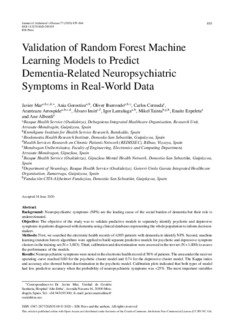Izenburua
Validation of Random Forest Machine Learning Models to Predict Dementia-Related Neuropsychiatric Symptoms in Real-World DataEgilea (beste erakunde batekoa)
Beste instituzio
Organización Sanitaria Integrada Alto DebaKronikgune. Osasun Sistemen Ikerketa Institutua
Instituto de Investigación Sanitaria Biogipuzkoa
Red de Investigación en Servicios de Salud en Enfermedades Crónicas (REDISSEC)
Red de Salud Mental de Gipuzkoa
Organización Sanitaria Integrada Goierri-Urola Garaia
Fundación CITA Alzheimer
Bertsioa
Bertsio argitaratua
Eskubideak
© 2020, IOS Press and the authorsSarbidea
Sarbide irekiaArgitaratzailearen bertsioa
https://doi.org/10.3233/JAD-200345Non argitaratua
Journal of Alzheimer's Disease Vol. Pre-press. N. Pre-press, pp. 1-10, 2021Argitaratzailea
IOS PressGako-hitzak
dementia
depressive symptoms
machine learning
neuropsychiatric symptoms ... [+]
depressive symptoms
machine learning
neuropsychiatric symptoms ... [+]
dementia
depressive symptoms
machine learning
neuropsychiatric symptoms
predictive model
prevalence
psychotic symptoms
real-world data [-]
depressive symptoms
machine learning
neuropsychiatric symptoms
predictive model
prevalence
psychotic symptoms
real-world data [-]
Laburpena
Background: Neuropsychiatric symptoms (NPS) are the leading cause of the social burden of dementia but their role is underestimated.
Objective: The objective of the study was to validate predictive m ... [+]
Background: Neuropsychiatric symptoms (NPS) are the leading cause of the social burden of dementia but their role is underestimated.
Objective: The objective of the study was to validate predictive models to separately identify psychotic and depressive symptoms in patients diagnosed with dementia using clinical databases representing the whole population to inform decisionmakers.
Methods: First, we searched the electronic health records of 4,003 patients with dementia to identify NPS. Second, machine learning (random forest) algorithms were applied to build separate predictive models for psychotic and depressive symptom clusters in the training set (N = 3,003). Third, calibration and discrimination were assessed in the test set (N = 1,000) to assess the performance of the models.
Results: Neuropsychiatric symptoms were noted in the electronic health record of 58% of patients. The area under the receiver operating curve reached 0.80 for the psychotic cluster model and 0.74 for the depressive cluster model. The Kappa index and accuracy also showed better discrimination in the psychotic model. Calibration plots indicated that both types of model had less predictive accuracy when the probability of neuropsychiatric symptoms was <25%. The most important variables in the psychotic cluster model were use of risperidone, level of sedation, use of quetiapine and haloperidol and the number of antipsychotics prescribed. In the depressive cluster model, the most important variables were number of antidepressants prescribed, escitalopram use, level of sedation, and age.
Conclusion: Given their relatively good performance, the predictive models can be used to estimate prevalence of NPS in population databases. [-]
Sponsorship
Diputación Foral de GipuzkoaProjectu ID
DFG/Programa Adinberri 2018//GIP/Construcción de un modelo predictivo de riesgo de trastornos de conducta y psicológicos asociados a la demencia mediante Machine Learning/PROTECTBildumak
Item honek honako baimen-fitxategi hauek dauzka asoziatuta:






















